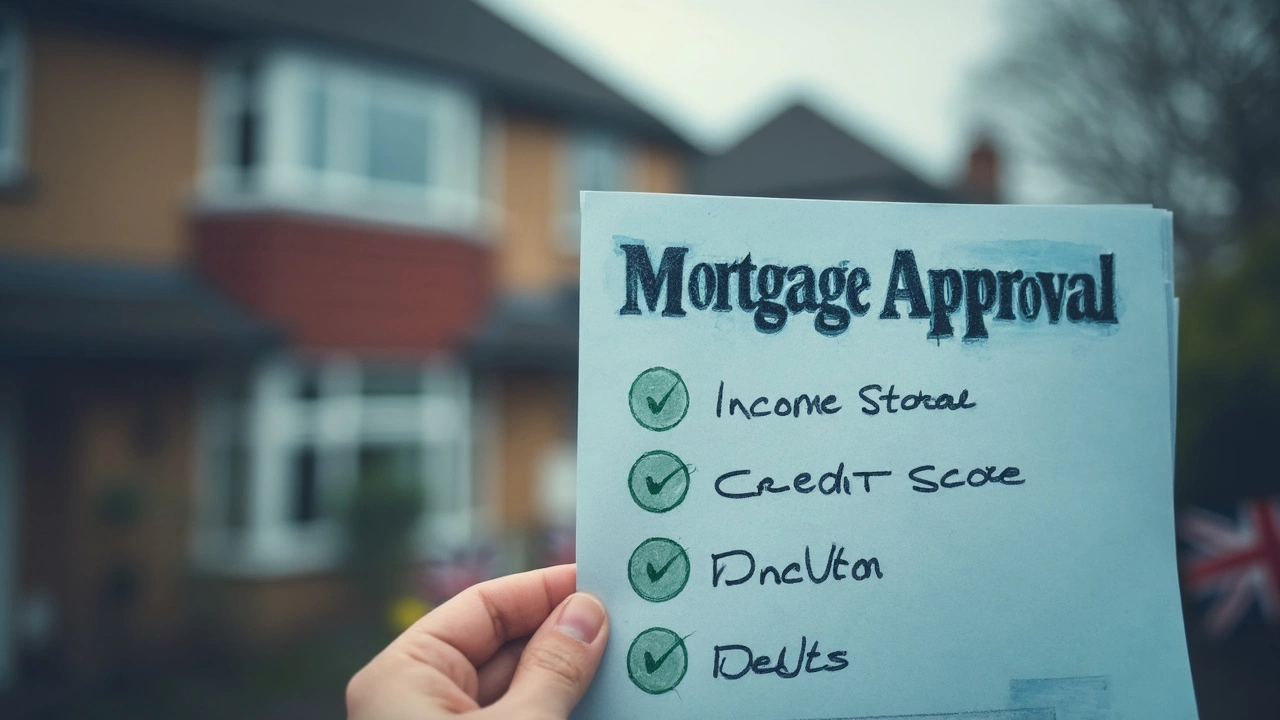Let’s get straight to the point—if you're dreaming about a $250,000 mortgage, the magic number you need to hit usually sits between $60,000 and $75,000 a year in household income. That’s assuming you’ve got decent credit and not a ton of debt hanging over your head. Lenders want to know you can handle the monthly payments, which—after property taxes, insurance, and all that jazz—can be about $1,800 a month depending on where you live and current rates.
Banks and lenders use something called the "debt-to-income ratio" to size you up. Most want your monthly debts—including the new mortgage—at or below 36% of your gross (pre-tax) income. If you have student loans, car payments, or credit card debt in the mix, you might need a bit more income to balance things out. It’s not just about how much you make, but what you owe every month too.
- Breaking Down the Numbers: Income Math
- Other Factors Lenders Care About
- Tips for Meeting the Income Target
- Hidden Costs You Can't Ignore
- What If You Don’t Qualify Yet?
Breaking Down the Numbers: Income Math
If you're wondering how much you need to earn for that $250,000 mortgage, here’s the breakdown. Lenders follow pretty strict rules, and the first thing on their checklist is your monthly gross income. The number they like to see is based on how much your monthly mortgage payment will be and how much other debt you’re carrying.
For a $250,000 mortgage with a 30-year term and a fixed interest rate (let’s say 6.5%, which was the average in early 2025), your monthly principal and interest payment is about $1,580. Add property taxes, homeowners insurance, and maybe some HOA fees, and it’s easily around $1,800 a month.
Lenders use the "28/36 rule"—your total monthly home payment (PITI: principal, interest, taxes, insurance) shouldn't be more than 28% of your gross monthly income, and total debt payments shouldn't top 36%. Here’s what that math looks like:
| Monthly Payment | Income Needed (28% Rule) | Income Needed (36% Rule w/Debt) |
|---|---|---|
| $1,800 | $6,430/mo ($77,200/yr) | $5,000/mo ($60,000/yr) — if you have little or no other debt |
This means if you’ve got almost no monthly debts beyond your future mortgage, $60,000 a year could get it done. If you’ve got loans or credit card payments, you’ll need more—closer to $77,000+ for a safer bet.
Want a quick estimate? Grab your gross monthly income and multiply by 0.28—that's about what lenders like to see for your mortgage qualification sweet spot.
- If you earn $5,500/month ($66,000/year), 28% is $1,540 (tight, but possible in low-tax areas).
- If you earn $6,500/month ($78,000/year), 28% is $1,820 (much safer for a $1,800/month payment).
If you’re a dual-income household, add up both your pre-tax incomes. Just remember, these numbers don’t include stuff like utilities or unexpected repairs. Make sure you’ve got wiggle room so you don’t end up stressed about every bill.
Other Factors Lenders Care About
Getting approved for a mortgage qualification isn’t just about your income. Lenders put your whole financial life under a microscope—credit score, job stability, savings, even your rent payment history. Here’s what else grabs their attention:
- Credit Score: Most lenders set the bar at 620 for a standard loan. But shoot for higher—scores above 740 can snag you a lower interest rate, saving you money every month.
- Employment History: Banks love stability. If you’ve been at your job for at least two years, it makes them feel warm and fuzzy about lending you money. Lots of job-hopping or gaps? Expect more questions or paperwork.
- Down Payment: The more cash you put down, the better. For a $250,000 mortgage, a standard 20% down payment means $50,000 upfront. Some first-time buyer programs let you start with 3%–5%, but anything less than 20% means private mortgage insurance (PMI).
- Cash Reserves: Lenders like to see a savings cushion—usually enough to cover two months of mortgage payments. It shows you won’t default if you hit a rough patch.
- Debt Load: Credit cards and car loans eat into how much you can borrow. The lower your other bills, the more you qualify for. Keeping your debt-to-income ratio under 36% is key, but under 30% is even better.
- Property Type: Condos and multi-family homes can have stricter rules than single-family houses. Some programs and lenders add extra requirements or fees.
For a quick comparison, check out this breakdown of common loan requirements for first-time buyers:
| Lender Requirement | Conventional Loan | FHA Loan |
|---|---|---|
| Minimum Credit Score | 620 | 580 |
| Down Payment | 3%–20% | 3.5% |
| Max Debt-to-Income | 36%–43% | 43% |
Don’t forget, lenders nose around for red flags like recent bankruptcies or big, mysterious deposits in your account. They want to know where your money’s coming from and that you aren’t hiding big risks.
"Lenders are looking for consistency—steady income, manageable debts, and a history of responsible borrowing," says Mark Fleming, Chief Economist at First American Finance.
Making yourself a strong candidate means building credit, saving up, and having your paperwork tidy. It isn’t rocket science, but every detail counts when you’re chasing that home loan.

Tips for Meeting the Income Target
If your paycheck doesn’t seem quite enough to land that $250,000 mortgage, don’t sweat it—there are real ways to boost your numbers or make lenders see you as a good bet. A few smart moves can help you hit that income sweet spot.
- Team Up on the Application. Applying with a partner, spouse, or even a trusted family member means you can combine salaries, which often easily pushes you past the income minimum for a mortgage qualification. Lenders will use both your incomes, and if you both have solid credit, you’ve got an even better shot.
- Cut Down Debt. Remember, lenders look at everything you owe each month. If you can pay off a car loan or tackle a chunk of your student debt, you drop your debt-to-income ratio and raise your qualifying power. Even wiping out a $100 monthly payment can make a difference.
- Find Side Hustles or Bonuses. Lenders count regular extra income—think reliable side gigs, steady part-time jobs, or yearly bonuses. Got freelance work or a weekend job that’s been steady for two years? That money can be added to your official income number.
- Negotiate or Boost Your Main Income. If you’re close to hitting your target but not quite there, it could be time for a chat with your boss. Annual raises, promotions, or switching to a higher-paying role can close the gap. It sounds obvious, but a lot of folks forget this when they focus only on budgeting instead of earning more.
- Pick a Lower Down Payment Program. Some loans only need 3% down, like the Fannie Mae HomeReady or Freddie Mac Home Possible. With less cash up front, you might qualify even if your current savings aren't epic—just expect a slightly higher monthly payment and maybe mortgage insurance.
No need to guess—use free calculators from lenders or sites like NerdWallet or Bankrate. Plug in your numbers, see where you land, and adjust till you hit the mark. It’s all about knowing your options and using every tool out there.
Hidden Costs You Can't Ignore
Grabbing a $250,000 mortgage isn’t just about the down payment and the monthly check to the bank. There are plenty of surprises waiting to ambush first-time buyers. Missing them can blow your budget fast, so let’s get real about what you’ll actually pay.
First up: Closing costs. These are the fees that hit you the day you buy—think loan origination fees, title insurance, appraisal, and more. Most buyers can expect to cough up about 2% to 5% of the home's price at closing. For a $250,000 place, that means anywhere from $5,000 to $12,500, and no, you can’t roll all of it into your loan.
Then there's property taxes and homeowners insurance. Lenders usually make you pay both monthly from the start, and the tab can run higher than many expect. Taxes depend on where your new spot is located. For example, the national average for property tax in 2024 was about 1.13% of a home’s value per year.
| Hidden Cost | Average Amount (for $250,000 Home) |
|---|---|
| Closing Costs | $5,000–$12,500 (one-time) |
| Property Taxes | $2,825/year |
| Homeowners Insurance | $1,200/year |
| Private Mortgage Insurance (PMI) | $1,250–$2,000/year (if down payment < 20%) |
| Maintenance/Repairs | 1%–2% of home value per year ($2,500–$5,000) |
And don’t forget about PMI—that’s private mortgage insurance. If your down payment is under 20%, you’ll have to pay this extra fee until you build more equity. It usually adds 0.5–0.8% of the loan amount each year to your bill.
Stuff breaks. Water heaters croak, roofs leak, HVAC units go on strike. Most experts suggest setting aside at least 1% of your home’s price every year for repairs and upkeep. That’s $2,500 on a $250,000 home, with expensive years sneaking up when you least expect it.
"Homeownership comes with costs people rarely consider—insurance, upkeep, and taxes can easily add up to thousands more than the monthly mortgage payment," says Jessica Lautz, Deputy Chief Economist at the National Association of Realtors.
If you’re buying in a community with a homeowners' association (HOA), tack on monthly or quarterly dues too. These can be anywhere from $50 to $400 a month depending on the neighborhood’s perks.
So, run your numbers, leave wiggle room in your budget, and remember: the real monthly payment is almost always higher than what the mortgage calculator spits out. That’s how you really keep a handle on your mortgage qualification and avoid nasty surprises.

What If You Don’t Qualify Yet?
So maybe you ran the numbers and your income doesn’t quite stack up for a mortgage qualification on a $250,000 home. You’re not out of luck—there are real, practical moves you can make to boost your chances next time you apply. Lenders are all about numbers, so small changes in your finances can make a big difference.
Start by checking your debt-to-income (DTI) ratio. It’s one of the main reasons people get turned down. Aim for a DTI under 36%, but if you’re higher, here are some ways to fix that:
- Pay down your debt: Knocking off a chunk of your credit cards or a car loan can lower your DTI fast. Even a few thousand dollars can tip the scale in your favor.
- Boost your income: Side hustles, working extra shifts, or even a part-time gig can nudge your numbers up just enough to qualify.
- Add a co-borrower: Applying with a partner or family member can combine incomes, making it easier for both of you.
- Fix your credit score: If your score’s below 620, work on paying bills on time and correcting any errors on your credit report. A higher score often means better mortgage terms too.
- Save for a bigger down payment: Putting more money down lowers your loan amount, which makes qualification easier—and might even drop your monthly payment.
Let’s look at an example. Here’s a table showing how different DTIs and credit scores might impact your odds:
| DTI Ratio | Credit Score | Approval Odds |
|---|---|---|
| 30% | 750+ | Very likely |
| 36% | 700-749 | Likely |
| 42% | 650-699 | Unlikely |
| 45%+ | <620 | Rare |
Don’t forget, programs for first time home buyers can really help. Some local and national programs offer lower down payments, flexible qualification rules, or cash assistance. Check out options from the FHA, state-level Homebuyer Assistance, or local credit unions. These can take a surprising amount of pressure off your salary needs.
And if you don’t qualify now, don’t rush. Give yourself 6 to 12 months to polish your finances, then check your numbers again. Many first-time buyers underestimate how much they can improve in just a year with focused action.


Corbin Fairweather
I am an expert in real estate focusing on property sales and rentals. I enjoy writing about the latest trends in the real estate market and sharing insights on how to make successful property investments. My passion lies in helping clients find their dream homes and navigating the complexities of real estate transactions. In my free time, I enjoy hiking and capturing the beauty of landscapes through photography.
view all postsWrite a comment